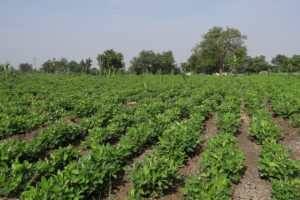Peanuts, often celebrated for their delightful taste and nutritional benefits, have an intriguing journey from seed to snack. Cultivating these crunchy, creamy legumes can be rewarding whether you’re a seasoned gardener or a novice enthusiast. In this guide, we’ll unveil the secrets to successfully growing peanuts in your backyard, offering valuable tips and creative insights.

Understanding Peanuts:
Before delving into the cultivation process, let’s take a moment to understand the plant itself. Peanuts, scientifically known as Arachis hypogaea, are members of the legume family, Fabaceae. Contrary to what their name suggests, peanuts are not nuts at all but rather seeds that develop underground. This unique growing habit makes them fascinating additions to any garden.
How to grow peanuts

Selecting the Right Varieties:
One of the first steps in growing peanuts is selecting the right variety for your growing conditions and culinary preferences. Virginia, Spanish, and Valencia are the three main types of peanuts, each with its own characteristics in terms of size, flavor, and shell color. Consider factors such as your climate, available space, and intended use (e.g., raw consumption, roasting, or making peanut butter) when choosing a variety.
Preparing the Soil:
Peanuts thrive in well-drained, sandy loam soil with a pH level between 5.8 and 6.2. Begin by preparing the soil bed by removing any weeds and debris. Incorporate organic matter such as compost or aged manure to improve soil fertility and structure. Avoid soils with high clay content, as they can hinder peanut development and increase the risk of fungal diseases.
Planting Peanuts:
Peanuts are typically planted in late spring or early summer when the soil temperature reaches at least 65°F (18°C). Sow peanut seeds directly into the prepared soil, spacing them 6 to 8 inches apart and burying them 1 to 2 inches deep. Ensure adequate spacing between rows to facilitate airflow and minimize the risk of disease.
Caring for Your Peanut Plants:
Once planted, peanuts require relatively low maintenance but benefit from regular attention to ensure optimal growth and productivity. Here are some essential care tips:
Watering:
Peanuts have shallow roots and are sensitive to drought. Water consistently to keep the soil evenly moist, especially during dry spells and periods of intense heat.
Fertilizing:
Apply a balanced fertilizer, such as 10-10-10, when the plants begin to flower to promote healthy growth and development. Avoid excessive nitrogen, as it can encourage foliage growth at the expense of peanut formation.
Weed Control:
Keep the area around your peanut plants weed-free to minimize competition for nutrients and reduce the risk of pests and diseases.
Pest and Disease Management:
Monitor your peanut plants regularly for signs of pests such as aphids, thrips, and leafhoppers, as well as common diseases like leaf spot and pod rot. Employ cultural practices such as crop rotation and proper sanitation to minimize the risk of infestation and infection.
Harvesting and Storing Peanuts:
As the peanut plants mature, they will begin to flower, followed by the formation of pegs that penetrate the soil to produce pods. Harvesting typically occurs 120 to 150 days after planting, once the leaves have turned yellow and the pods have reached full size. Carefully lift the plants from the ground and shake off excess soil, then allow them to dry in a well-ventilated area for 7 to 10 days.
After drying, remove the peanuts from the plants and shell them by hand or using a mechanical sheller. Store the shelled peanuts in a cool, dry place in a breathable container to prevent mold and prolong freshness. Properly cured and stored peanuts can last for several months, providing you with a delicious and nutritious snack long after the harvest season has passed.

Conclusion:
Growing peanuts at home is a delightful journey filled with discovery and satisfaction. By understanding the needs of the plants, selecting the right varieties, and providing proper care, you can enjoy a bountiful harvest of these versatile legumes right in your own backyard. So roll up your sleeves, dig into the soil, and embark on your peanut-growing adventure today!




